Discover expert insights on LED display projects, product selection, and display technology — all in one place. Our resource center brings together real-world case studies, professional buying guides, and in-depth technical knowledge to help you make the right decisions for your LED screen needs. More industry focused content, including installation best practices and market trends, is continuously curated to support your long-term success.
How to Choose & Check a High-Quality LED Display: A Professional 4-Step Quality Control Guide
LED displays are high-precision electronic systems, widely used in outdoor advertising, live events, control rooms, and conference halls — where clarity, stability, and long service life are non-negotiable. But how do you check the quality of an LED screen before buying or installing it? In this guide, we’ll walk you through a professional 4-step quality control process, from pre-production to post-installation support, to help you choose a high-quality, reliable LED display that delivers excellent ROI.
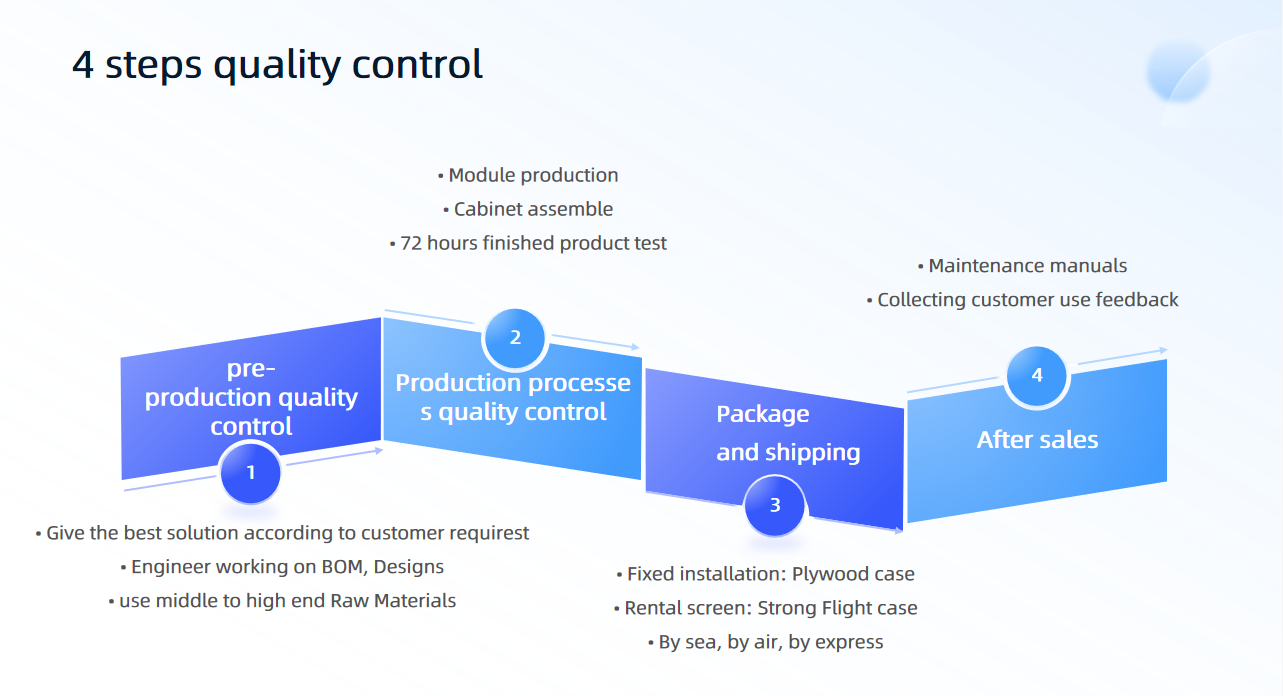
1. Why LED Display Quality Matters
High-quality LED displays ensure vivid visuals, stable performance, and longer lifespan. Poor quality screens can result in:
• Frequent module failures
• Uneven brightness and color blocks
• Costly maintenance and return issues
• Damaged brand reputation
Table of Contents
1. Why LED Display Quality Matters
2. 4 Steps to Control LED Display Quality
•2.1 Step 1: How to Check the Quality of an LED Display Before Production
- Key Quality Control Measures Before Production
•2.2 Step 2: Quality Control During LED Display Production
2.2.1 How to Check the Quality of LED Display Modules?
2.2.2 What Affects LED Cabinet Assembly Quality?
2.2.3 Final Quality Checks: How to Tell If an LED Display Is Good or Not
•2.3 Step 3: LED Display Packaging and Shipping Quality Control
•2.4 Step 4: After-Sales Service and Support for LED Display Projects
3. How to Choose a Reliable LED Display Supplier — And Why Vanxled Is a Smart Choice
4. FAQs About LED Display Quality Control
5. Conclusion: Why LED Display Quality Control Is Critical for ROI
2. 4 Steps to Control LED Display Quality
2.1 Step 1: How to Check the Quality of an LED Display Before Production
Before production starts, it's essential to check the key quality factors that determine LED screen performance, from
LED chips to power supply and circuit design.
2.1.1 Key Quality Control Measures Before Production
·LED chip selection (e.g., Nationstar, Kinglight) for brightness and color consistency
Our factory has established long-term partnerships with top LED chip brands such as Nationstar and Kinglight, ensuring
stable supply and consistent visual performance across all LED display screens.
·PCB board quality inspection for thermal conductivity and durability
Our LED displays are built with high-quality PCBs featuring excellent thermal conductivity and strong resistance
to high temperatures, ensuring stable performance and extended lifespan,especially in demanding environments
like outdoor LED screens and rental LED video walls.
·IC driver testing for high refresh rate and grayscale precision
We use high-performance ICs with a high refresh rate to ensure that our LED displays deliver smooth, flicker-free visuals. even when captured on phone cameras. Whether you're taking photos or recording videos, the LED screen looks crystal clear without scan lines or flickering
·Power supply directly affects the display stability, brightness, color consistency, lifespan and safety of LED display screen Although reliable power supplies account for about 5%-8% of the total screen cost, they can reduce maintenance costs by more than 60% in the long time. The quality of LED display power supply is the core component to ensure its high operation. We work closely with trusted power supply brands such as Mean Well, Chuanglian, and Juneng, known for their long-lasting durability and stable performance. These LED display power supplies have been proven to run reliably for 5 to even 10 years in both indoor and outdoor LED screen installations.
·LED Display Cable Quality Impacts Signal Transmission, Safety, and Image Stability
High-quality LED display cables ensure stable signal transmission, reduce electromagnetic interference, and prevent flickering or black screens. Discover how to choose the right cables for rental and fixed LED displays.
·BOM matching + pilot run validation to ensure design feasibility and cost efficiency
Before mass production of any LED display, we strictly follow the BOM (Bill of Materials) to carry out a first article inspection. Only after the sample passes all quality and performance tests do we proceed to full-scale production to ensuring every LED screen meets our standards from the very beginning.
2.2 Step 2: Quality Control During LED Display Production
2.2.1 How to Check the Quality of LED Display Modules
The following are the key quality assurance when we produce LED display modules
• LED Lamp Baking: To Ensure functioning and prevent dead lights
• SMT for electronic components: To Ensure functioning and prevent dead lights
• Reflow Soldering: To Ensure functioning and prevent dead lights
• Semi-finished led module test:To Ensure functionality before proceeding to the next stage
• Coat with three-proof paint: To Ensure functioning and prevent dead lights
• Install the bottom case for PCB: To prevent leakage during the subsequent black glue injection process
• Glue Filling: For outdoor waterproof to protect the surface
• Cover mast: To improve the contrast and protect LED.
·24 hour aging test on LED modules to screen for dead pixels and color deviation
·Brightness & color calibration to ensure uniform visual performance across all modules
·Functional testing for refresh rate, grayscale, and signal response
• Package & ready to ship out:Some modules need to install handles and quick locks for fast maintenance
2.2.2 What Affects LED Cabinet Assembly Quality?
The following are our assembly quality standards for LED Display Cabinets
·Structure inspection: The cabinet structure is welded firmly, without virtual welding or missing welding.
·Power supply and wiring: The wiring is standardized, with strong antiinterference and clear plug identification.
·Module and cabinet fit: Seamless splicing, magnetic suction/screw fixation is firm
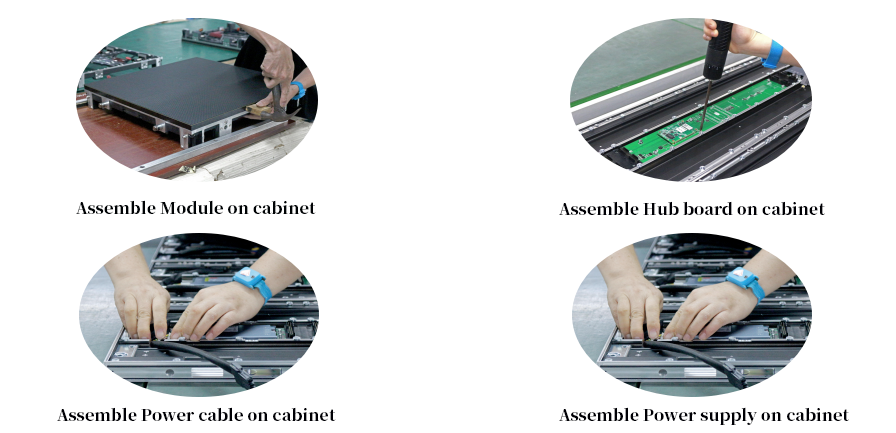
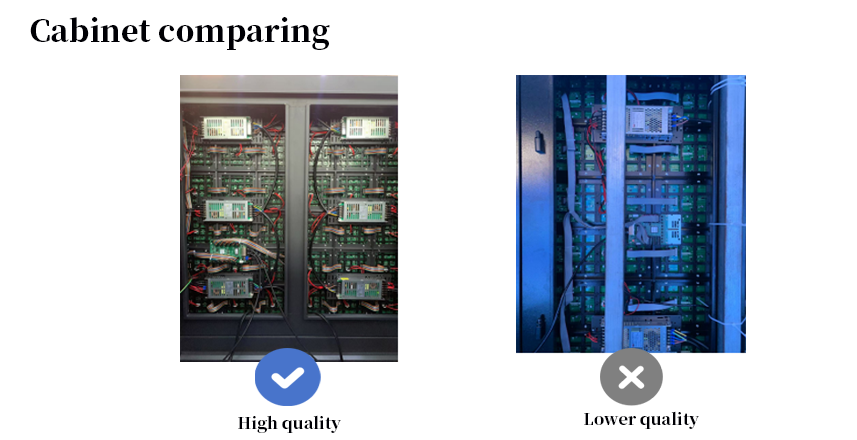
2.2.3 Final Quality Checks: How to Tell If an LED Display Is Good or Not
Wondering how to tell if an LED display is good or not before shipment? Here's what we do to guarantee your LED screen performs reliably out of the cabinet
• To choose a high-quality LED display, you need to understand how to test the quality of an LED display—look for suppliers who perform comprehensive quality checks, including full-screen aging tests for 72 hours (cycling red, green, blue, white colors with video playback), brightness and color calibration, refresh rate and grayscale verification, waterproof testing for outdoor models, and provide detailed inspection reports to ensure long-term stability and performance.
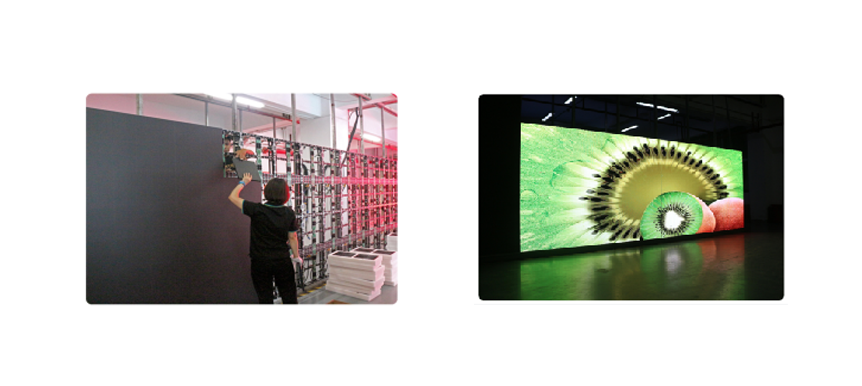
• To choose a high-quality LED display, it's important to know how to configure the LED screen properly—ensure the supplier supports professional control system debugging using platforms like NovaStar or Colorlight, and provides correct configuration including LED screen mapping, resolution, scan mode, brightness, and refresh rate settings to guarantee stable performance and seamless playback across all modules.
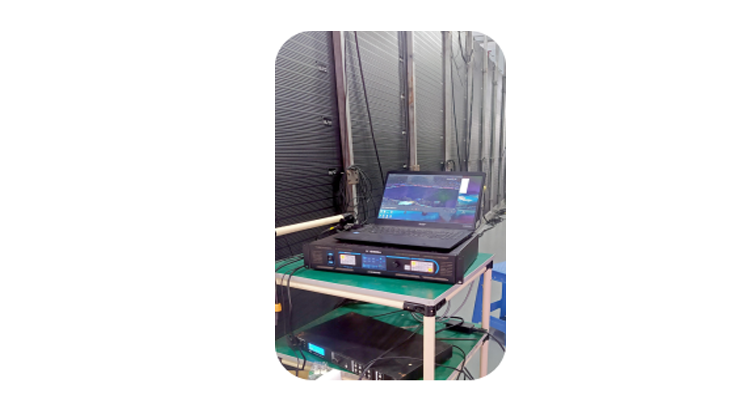
• Finished product acceptance report: we will record the testing result of brightness, power consumption, display stability, etc.,If all passed the quality standard, QC will approve to ship out the goods
2.3 Step 3: LED Display Packaging and Shipping Quality Control
we use internationally standard packaging to pack the LED display screen for international shipment. Proper packaging is key when considering how to configure LED screens for long-distance delivery

LED Module usually Package by carton case package or strong plywood case package

Fixed installation led display usually package by international standard of strong plywood case

Rental led display usually use strong flight case package
Proper packaging is not only about protection, it ensures your LED display screen arrives in perfect condition, with pixel pitch alignment and LED module integrity fully intact
2.4 Step 4: After-Sales Service and Support for LED Display Projects
We have builds reliable after sale service team to support lifetime after sale service
• 24/7 technical support via video call or remote software (NovaLCT, ViPlex)
• Spare parts management — fast replacement shipping from local or central warehouses
• Warranty support from 1 to 5 years, with optional extended free service and life time paid after sale service
3. How to Choose a Reliable LED Display Supplier — And Why Vanxled Is a Smart Choice
Choosing the right LED display supplier is not just about finding the lowest price — it's about long-term reliability, consistent performance, and trustworthy support. Whether you're sourcing screens for permanent installations, rental events, or resale, the supplier you choose will directly impact your project's ROI and your brand reputation.
Here’s a professional checklist to evaluate any LED screen supplier — and how Vanxled checks every cabinet with confidence:
3.1 Proven Manufacturing & Quality Control Standards
Not all factories follow the same level of quality control. Ask suppliers if they provide:
• First article inspection based on full BOM
• Full 72-hour aging test (RGBW + video mix)
• Brightness, color, and grayscale calibration
• Waterproof, shockproof, and vibration testing (for outdoor/rental displays)
✔ Why Vanxled: our factory passed ISO9001-certified, CE/RoHS compliant, and 100% full QC inspection before shipment, including detailed testing reports with each order.
3.2 Transparent Supply Chain and Brand Components
A reliable LED supplier doesn’t cut corners. Evaluate:
LED chip brands used (e.g., Nationstar, Kinglight)
Power supply and IC driver sources
PCB board material and thermal resistance
Clear documentation of BOM
✔ Why Vanxled: Partners with leading brands like Mean Well, Chuanglian, Nationstar; and ensures BOM traceability for every project.
3.3 Fast Lead Time and Global Shipping Capabilities
Timely delivery is critical, especially for rental events or time-sensitive projects.
Can the supplier manufacture within 7–12 working days?
Do they offer flight case / plywood case / carton options?
Is international packaging export-standard?
✔ Why Vanxled: 7–12 day production capacity with secure global packaging and shipping options tailored to fixed or rental screens.
3.4 Responsive After-Sales Service
Great suppliers stand by their products — even after delivery.
Do they offer remote technical support (e.g., NovaLCT / ViPlex)?
Are spare parts stocked locally or centrally?
What is their warranty and replacement policy?
✔ Why Vanxled: 24/7 technical team, lifetime paid support, 1–5 year warranty, and fast spare part delivery from global warehouses.
3.5 Real Customer Trust and Global Recognition
Client feedback is one of the most honest ways to assess a supplier.
How many countries do they serve?
Do they have repeat clients or high reorder rates?
Are case studies or testimonials available?
✔ Why Vanxled: Trusted by clients in 90+ countries, with long-term partnerships across rental, retail, broadcast, and control room sectors.
4. FAQs About LED Display Quality Control
Q1: What tests are done to ensure LED display module quality?
A: We perform automated optical inspection (AOI), 72-hour aging tests, brightness calibration, and color consistency checks
for each LED module. These steps help ensure long-term reliability and prevent issues like dead pixels or uneven brightness
Q2: How do you ensure the LED display won’t flicker when filmed?
A: We use high-refresh rate IC drivers (≥1920Hz or 3840Hz), which eliminate flickering or scan lines when captured by phone
or professional cameras. This is essential for rental LED displays used in events and live broadcasts.
Q3: What is first article testing, and why is it important?
A: Before mass production, we run a first article test based on the full BOM (Bill of Materials) to verify compatibility, performance, and design correctness. Only after this sample passes inspection do we proceed with bulk manufacturing.
Q4: How do I check if a LED display has the right resolution for my project?
A: First, understand your viewing distance and pixel pitch requirements. For indoor applications, a smaller pixel pitch (e.g., P1.5 or P2.0) ensures higher clarity. Use this formula to calculate LED screen resolution:
Resolution = Width (in pixels) × Height (in pixels). We’ll guide you through screen mapping and system configuration during setup.
Q5. What is the best resolution for LED screen?
A: The best resolution for an LED screen depends on the viewing distance and the type of content being displayed. For example, in indoor environments like conference rooms or retail stores where viewers are closer to the screen, a higher resolution LED display (such as P1.5 or P2.5) is ideal to ensure sharp, detailed visuals. In outdoor or large event settings where people view the screen from a distance, a lower resolution like P4 or P6 is often sufficient and more cost-effective. In short, the best resolution for your LED screen is the one that balances visual clarity with viewing distance and budget.
Q6: How to calculate LED screen resolution?
A: To calculate LED screen resolution, multiply the number of pixels per meter (determined by pixel pitch) by the physical dimensions of the screen. For example, if you're using a P2.5 LED module (which means a 2.5mm pixel pitch), that translates to 400 pixels per meter. So, if your screen is 3 meters wide and 2 meters high, the resolution would be:
Horizontal pixels = 3 x 400 = 1200
Vertical pixels = 2 x 400 = 800
Your LED screen resolution would be 1200 x 800. This formula is essential when choosing the right display for content like HD videos, text, or presentations.
Q7: What is LED screen mapping?
A: LED screen mapping is the process of aligning the physical LED panels with the virtual layout in the control system, ensuring that video and content are displayed correctly across the screen. It’s especially important when working with rental LED displays or irregular screen shapes. Proper LED screen mapping helps prevent visual issues like misaligned content, blank modules, or wrong color regions. This step is usually done using LED software like NovaLCT or Colorlight, and it's a key part of LED screen configuration before going live with any event or installation.
Q8: How do you guarantee consistency across multiple LED cabinets?
A: We conduct cabinet flatness comparison, color and brightness uniformity tests, and ensure precise module-to-cabinet alignment. This guarantees seamless visuals when assembling multiple panels.
Q9: Do you offer after-sales service or warranty?
A: Yes. We provide 24/7 technical support, fast-shipping of spare parts, and lifetime maintenance service. We also offer remote debugging via NovaLCT or ViPlex software to help clients quickly resolve issues.
5. Conclusion: Why LED Display Quality Control Is Critical for ROI
Whether you're a system integrator, LED rental company, or project manager, quality control in LED display manufacturing is the key to reducing downtime, boosting customer satisfaction, and ensuring long-term profits. Looking for a QC-certified supplier? Vanxled offers strict quality control across all production stages, with full documentation, inspection reports, and global support.
[Contact Us for a Free Sample + Quality Control PDF]
Consulting solutions for Your Project

 Whatsapp Business:008613823234994
Whatsapp Business:008613823234994 E-mail: info@bestscreen.cn
E-mail: info@bestscreen.cn Subscribe
Subscribe














 Address: Block1, Jiada Industrial Park, the northern section of Tangtou Avenue, Shiyan Street, Bao‘an District, Shenzhen, China
Address: Block1, Jiada Industrial Park, the northern section of Tangtou Avenue, Shiyan Street, Bao‘an District, Shenzhen, China Phone: 008613823234994
Phone: 008613823234994 Email: info@bestscreen.cn
Email: info@bestscreen.cn

